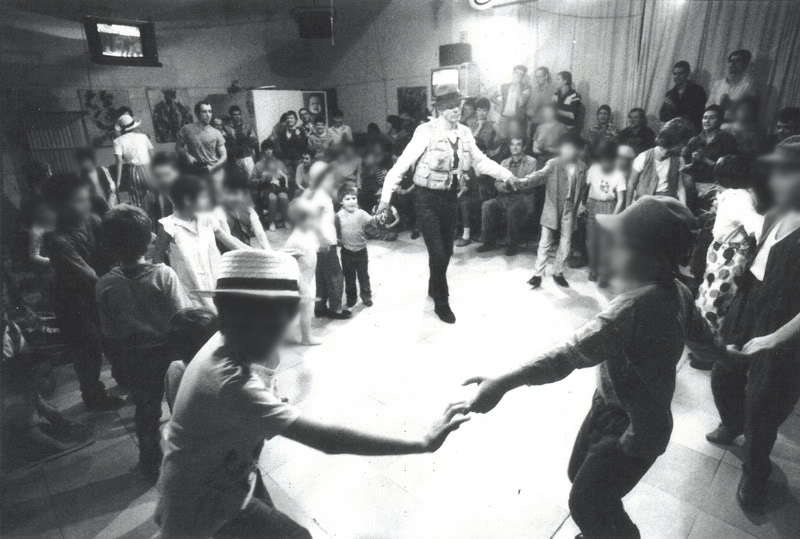In a boutique hotel lobby in London’s former docklands, Ziggy Marley’s earnest cover of “Blowing in the Wind” plays softly over the public address system, and a man in early middle-age enters through the sliding doors. He walks past the hotel luggage trolleys, and collects his ironed shirts from behind the reception desk. A whale-sized lump of abstract sculpture hangs above said desk.
Copies of Time Out sit on the coffee tables, and a multicoloured chalkboard outlines this week’s activities on offer: circuit training in the gym, a ‘summer screams’ film night, a relaxation session, a running club, and then Sunday is ‘Tarantino time!’, with a screening of Django Unchained. Three-quarters of the hotel is gleaming new, and the golf simulator, spa and mindfulness zone, like the swimming pool on the 20th floor and its adjoining bar, are all nearing completion. Except…
Videos by VICE
… This is not a hotel. Nor is it an ultra-luxe student halls of residence or a block of luxury flats. This is The Collective Canary Wharf, the world’s largest co-living space, standing at 21 storeys high, containing 705 ‘micro-apartments’, and a whole lot more besides. It looks like student halls and a campus, rolled into one building – but for wealthy, mostly young-ish professionals. “Co-living” in this sense means you get tiny apartments and large shared spaces, with everything laid on in-house.

Located in the Isle of Dogs, but described as Canary Wharf, because that more eloquently screams ‘luxury’, this is the latest of The Collective’s numerous planned co-living blocks so far, in the UK, US and Germany. The company, founded in 2010, now has a property portfolio with a combined value of £2.7 billion.
Of course, this type of living has been around for a while. A Failed Architecture piece detailed that co-living spaces like The Collective are “not a new way of living, [but] an old one, commodified”, tracing the history of 1930s modernist pioneers who saw the possibility of housing that allowed for shared spaces beyond the nuclear family. There’s also the model of 1960s Scandinavian ‘cohousing’ communities for pensioners. But the difference is that co-living spaces like these seem engineered to maximise profits during an apparently unending housing crisis, which disproportionately affects young people.
In an age where UK housing is a shit show – i.e: the London Mayor is unable to introduce rent controls, as the current Government’s shared ownership plan gets people into more debt – The Collective’s breed of co-living can seem attractive. If only their rooms weren’t so expensive. The Cosy apartments, for example, are about the size of a single bedroom, with an ensuite bathroom and a two-hob ‘kitchen’ squeezed beside a queen-sized bed. These come in at £1,863pcm if you’re staying three months (£1,430pcm, for a year) – either way, this works out substantially more than half the average UK salary. The bigger apartments on offer sail north of £2,000pcm, and they’re still studio flats; still only one room.
The Collective aren’t alone in boujee co-living either. If you’ve travelled on a London underground train, you’ve likely seen the ubiquitous adverts for Tipi London, calling on young Londoners to “join the rental rebellion” – via familiar red-and-black Soviet constructivist-style propaganda posters, but delivered by 21st-century rentier super-landlords. Here, renters paying £1,900pcm for a one-bed flat are “rebels who have joined the cause”. Yet when you get down to it, what is ‘revolutionary’ about the approach largely amounts to no letting fees or deposit, with bills included in the extortionate monthly fees.
The emphasis in these places is largely on the shared facilities. In The Collective, that’s not just the gym and the cafe and the pool, but the cleaner, the library, the ‘breakout spaces’, the big shared kitchen, the cinema and TV rooms, the ‘play room’ with toy swords and ping-pong, adorned with handwritten notes on the pastel-coloured walls, as if the team behind Innocent Smoothies’ twee packaging had been signed up to do the decor. As if the co-living spaces are part of a trend in adults regressing back to their youth, spending their evenings at Ballie Ballerson.

The age of those leading the co-living boom seems relevant to this. The Collective’s CEO, Reza Merchant, is just 30. He is a regular at Burning Man, and once guested in an episode of Made in Chelsea (he was up for bids at a ‘man auction’). The average tenant in their existing UK block in Old Oak, north-west London is 28. Tenants can pay their rent in bitcoin, and the Canary Wharf branch launched recently with a party hosted by Erol Alkan.
Last year, Merchant told Forbes they had 4,500 co-living ‘apartments’ planned across the UK, US and Germany, and was bidding on sites that would allow for another 5,000 on top of that. It is, they say, “a global living movement” – and sure enough, sections of the web are abuzz with listicles about co-living spaces from Morocco to Switzerland. Sadly, if co-living is a bubble, it’s not one that’s about to burst just yet.
More
From VICE
-

Collage by VICE -

A woman looks at the tributes on the memorial wall next to Grenfell Tower. Photo by Vuk Valcic/ZUMA Press Wire/Shutterstock -

Children at the Friedrichshof Commune dance with renowned artist Joseph Beuys. Inka, aged four, holds his right hand. -

Collage by Vice
